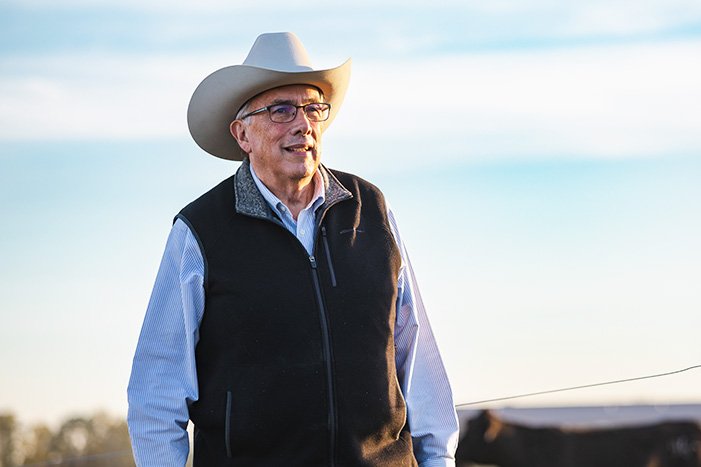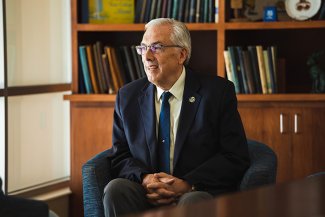
Editor's note: This article was first published in the July/August 2023 edition of South Dakota Magazine and is republished with the magazine's permission.
Claude Lamoureaux was a cowboy and an Indian. For a boy growing up in the 1950s, that was just about the coolest thing ever. He was also my grandfather. As a little boy, I followed him everywhere I could, though he was tough to keep up with.
He, and my grandma Hattie, ranched south of Mission, South Dakota, on the Rosebud Reservation. My boyhood memories are of driving across the ranch in his green Chevy pickup truck, checking the cattle and windmills, making sure gates were closed and fences were tight, seeking some reassurance that everything was OK. Many times, we rode horses, and from early on, I saddled my own. He was never very talkative, but I peppered him with questions, to the point of his annoyance, which I learned to recognize as the time for me to be quiet. I have no memory of him telling me he loved me. No memory of him tucking me into bed or playing games. Yet, I always knew he loved me. On horseback, in his truck, or around the supper table, he taught me many, many lessons. Most of which I understand much better today, than when I was a gangly boy. I know that he was a very good man.

I graduated from high school at Christmastime, so that I could work full time on the ranch. Grandma died soon after, and I found myself alone with my grandpa Claude. He was grieving. And I was trying to grow up. It was a poignant time for both of us.
By then his brown skin was darkened and wrinkled from a hard life, defined by scarcity. He wasn’t a tall man, but he was still rugged and straight, and his love for the land was obvious to me. A member of the Sicangu Lakota, he was born on the Rosebud Reservation south of what is now Winner in 1892, just two years after the Wounded Knee massacre on the nearby Pine Ridge Reservation. The stories he told me of growing up were of very tough times. Being the oldest, Claude and his brother, Howard, were sent to a boarding school in Academy, a tiny community west of Platte.
Academy was across from the eastern border of the reservation, which at the time was the Missouri River. To get to school in the fall, he and Howard swam their horses across the low Missouri stream. In the spring, they had to ferry across the high water and then ride the 80-plus miles home.
As a teenager, he rode in the last open range roundups in the Dakotas, clearing the reservations of Texas cattle to open the way for homesteaders. He described the landscape as a beautiful, endless grassland, except for the occasional cottonwood groves which were a sign of water, and perhaps shelter.
In 1929, out of financial desperation, my grandpa took grandma and my mother and her brothers to Sioux City, Iowa, for work. He returned to the Rosebud after World War II, and bought a place called the Antelope Ranch from C.J. Grossenburg, the well-known Winner implement dealer. Using his Indian preference status and also by buying abandoned homesteads, he put together 12,500 acres and renamed it the L7 Ranch.
Most ranchers will talk about their prize cattle or their best horses. Grandpa Lamoureaux was also proud of his livestock, but his true love was for the land. During the homestead era, and as part of their homestead contract, the farmers had plowed nearly every flat acre they could find. When they failed during the Dust Bowl, the land was left scarred and unproductive. Grandpa used to say that weeds were Mother Nature’s way of covering her nakedness, and he found the old fields covered with weeds.
Without understanding the modern concepts of ecological succession, he called those fields “go back,” meaning they were trying to go back to their native condition. He knew that planting grass would hurry the healing, and working with the Soil Conservation Service, he planted hundreds of acres of scarred and blowing land back to both introduced, as well as native grasses.
He planted alfalfa with cool season grasses because he knew it was a natural fertilizer for hay ground. He knew the pastures needed to be properly stocked, and so he was careful to put just the right number of cattle in each pasture.
As beavers had been eliminated from the landscape a century earlier by fur trappers, he understood that by building a series of small dams along Antelope Creek, he could raise the water table for the entire valley, increasing its productivity and providing water for livestock and wildlife.
My grandpa didn’t use fancy words when he talked about conservation and stewardship. He was pragmatic, even blunt at times. He didn’t mention his Lakota heritage as part of his values, but upon reflection, they were on clear display. His principles and practices are timeless and eloquent.
He loved the treeless prairie and taught me to love it. One year, he won a Todd County Conservation District award, and he was proud of the recognition—as I was for him. For all I knew at the time, it was a Nobel Prize.
My career as a conservationist was inspired by my grandfather and then solidified through my education and work at South Dakota State University. From earning my undergraduate degree in biological sciences in 1975, securing a master’s in 1977 and a doctorate degree in 2000, I’ve had many opportunities to learn more about the ecology of our great state.
Many years after that eventful spring and summer following Grandma’s death, I saw a quote by the famous conservationist Aldo Leopold that reminds me of my grandfather. “The land ethic simply enlarges the boundaries of the community to include soils, waters, plants and animals, or collectively: the land,” Leopold said. “In short, a land ethic changes the role of Homo sapiens from conqueror of the land-community to plain member and citizen of it. It implies respect for his fellow members, and also respect for the community as such.”
For the past dozen years, one of my most rewarding activities at SDSU has been to play a small part in honoring landowners with the South Dakota Leopold Conservation Award. In August 2022, I spoke about the essence of conservation at a ranch tour with the 2022 Leopold award winners, the Neil Bien family, who ranch near Veblen.
Neil told the story of how his grandmother taught her children a conservation ethic. They were allowed to pick just a single flower from the roof of their sod house, so as to not reduce the seed bank for future flowers. When the earth worms found their way into her sod house, she carried them out and let them live to do the important work that earth worms do.
It’s a beautiful story. It warmed my heart, and it reminded me of riding horseback across the treeless prairie with my grandpa Claude. Like Neil’s grandmother, my grandfather instilled in me a conservation ethic. Culturally and geographically, they were far apart in South Dakota but they both taught their children and grandchildren to see the prairie. To understand it. To enjoy it. In fact, to cherish it.
My grandpa was an old man when he built his dams, planted grass and stocked his pastures. He didn’t live much longer than my grandma, as he couldn’t live without her. He wasn’t around to see, or personally benefit from, most of his conservation work. He didn’t have to take the responsibility to leave the land better than when he found it, but I am certain that he believed he did. His conservation work and land stewardship were expressions of his values. His land ethic. It inspired me then and it does today.
As I mentioned, Grandpa wasn’t one much for talking, but his actions spoke volumes to me. His land ethic instilled in me a love and respect for every blade of grass, each butterfly that flutters bye, and even an unconventionally located bird’s nest. He is the reason I brush worms back into the dirt from sidewalks, pick up litter and trash and recycle everything that is accepted. Words cannot always teach us values like these, but I know actions will.
Will our grandchildren and great-grandchildren have the same opportunities? Will they experience the beauty of a swallow tail butterfly in its natural environment? Will they hear a meadowlark sing and marvel at a red-tail hawk on the hunt, flying low across the prairie?
I am concerned that they will not. Over the last several decades, native grasslands in South Dakota have dramatically declined in total acres. And with it biodiversity and value we can’t possibly measure.
Fortunately, we know what to do. We know the basics of ecology. We know the importance of soil health. We know the principles of good range management. We know the many benefits of grasslands. We know that conservation pays. We have Leopold Conservation Award winners to learn from and emulate.
We know what to do. But can we muster the common sense and selfless spirit of our grandparents to do it? That is the question for us today.
About the Leopold Conservation Award
The Leopold Conservation Award Program recognizes agricultural landowners actively committed to a land ethic. Sand County Foundation, national sponsor American Farmland Trust and several prominent state conservation partners present the prestigious honor, which consists of $10,000 and a crystal award, in settings that showcase the landowners’ achievements among their peers.
The Leopold Conservation Award is a productive investment in private lands conservation. It recognizes and celebrates extraordinary achievement in voluntary conservation by private landowners, inspires countless other landowners by example and provides a prominent platform by which agricultural community leaders are recognized as conservation ambassadors to citizens outside of agriculture. Finally, the program builds bridges between agriculture, government, environmental organizations, industry and academia to advance the cause of private lands conservation.*
South Dakota has presented the Leopold Conservation Award a dozen times.
- 2010, Doud Ranch, Midland;
- 2011, Mortenson Ranch, Hayes;
- 2012, Korpiva Angus, Raymond;
- 2013, Guptill Ranvh, Quinn;
- 2014, Rock Hills Ranch, Lowery;
- 2015, Jorgensen Land & Cattle, Ideal;
- 2016, Cronin Farms, Gettysburg;
- 2017, Blue Bell Ranch;
- 2018, Cammack Ranch, Union Center;
- 2019, Johnson Farms, Frankfort;
- 2020, Blair Brothers Ranch, Sturgis;
- 2021, Prairie Paradise Farms, Fort Pierre;
- 2022, Bien Ranch, Veblin; and
- 2023, Slovek Ranch, Philip.
*From sandcountyfoundation.org
- Contact:
- Telephone number: 605-688-4111
Republishing
You may republish SDSU News Center articles for free, online or in print. Questions? Contact us at sdsu.news@sdstate.edu or 605-688-6161.

